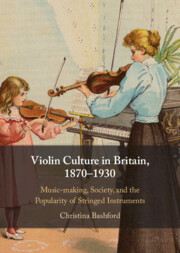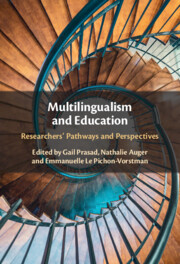Refine search
Actions for selected content:
23 results
6 - Playing Together (1)
- from Part I - People and Practicalities
-
- Book:
- Violin Culture in Britain, 1870–1930
- Published online:
- 13 September 2025
- Print publication:
- 18 September 2025, pp 163-188
-
- Chapter
- Export citation
7 - Playing Together (2)
- from Part I - People and Practicalities
-
- Book:
- Violin Culture in Britain, 1870–1930
- Published online:
- 13 September 2025
- Print publication:
- 18 September 2025, pp 189-216
-
- Chapter
- Export citation
4 - Advanced Training
- from Part I - People and Practicalities
-
- Book:
- Violin Culture in Britain, 1870–1930
- Published online:
- 13 September 2025
- Print publication:
- 18 September 2025, pp 104-128
-
- Chapter
- Export citation
3 - Moving Along
- from Part I - People and Practicalities
-
- Book:
- Violin Culture in Britain, 1870–1930
- Published online:
- 13 September 2025
- Print publication:
- 18 September 2025, pp 74-103
-
- Chapter
- Export citation

Violin Culture in Britain, 1870–1930
- Music-making, Society, and the Popularity of Stringed Instruments
-
- Published online:
- 13 September 2025
- Print publication:
- 18 September 2025
Chapter 24 - The Abbey Theatre
- from Part IV - Performance Legacies
-
-
- Book:
- Sean O'Casey in Context
- Published online:
- 23 June 2025
- Print publication:
- 10 July 2025, pp 257-268
-
- Chapter
- Export citation
Chapter 28 - The French Stage
- from Part IV - Performance Legacies
-
-
- Book:
- Sean O'Casey in Context
- Published online:
- 23 June 2025
- Print publication:
- 10 July 2025, pp 308-317
-
- Chapter
- Export citation
3 - A New Cycle of Protests
- from Part I - Context
-
- Book:
- The Making of Leaderful Mobilization
- Published online:
- 30 January 2025
- Print publication:
- 06 February 2025, pp 65-88
-
- Chapter
- Export citation
Chapter 39 - Columbia Records and Deutsche Grammophon
- from Part VI - The Legacy
-
-
- Book:
- Leonard Bernstein in Context
- Published online:
- 06 April 2024
- Print publication:
- 28 March 2024, pp 331-338
-
- Chapter
- Export citation
Pandemics and Paradigms of Contestation
-
- Journal:
- Canadian Journal of Law & Society / La Revue Canadienne Droit et Société / Volume 38 / Issue 3 / December 2023
- Published online by Cambridge University Press:
- 21 February 2024, pp. 299-315
-
- Article
-
- You have access
- Open access
- HTML
- Export citation
Chapter 32 - Puccini and the Canon
- from Part VIII - Legacy
-
-
- Book:
- Puccini in Context
- Published online:
- 31 August 2023
- Print publication:
- 14 September 2023, pp 264-271
-
- Chapter
- Export citation
Chapter 29 - Molière at the Hôtel Guénégaud and the Comédie-Française: The Early Years
- from Part VI - Afterlives
-
-
- Book:
- Molière in Context
- Published online:
- 10 November 2022
- Print publication:
- 24 November 2022, pp 275-284
-
- Chapter
- Export citation
4 - Cantonese Opera and the Layering of Space on the Australian Goldfields
-
- Book:
- Visualising Lost Theatres
- Published online:
- 18 August 2022
- Print publication:
- 25 August 2022, pp 96-126
-
- Chapter
- Export citation
2 - (In)forming Repertoire
-
- Book:
- Music Theatre and the Holy Roman Empire
- Published online:
- 14 June 2022
- Print publication:
- 07 July 2022, pp 81-125
-
- Chapter
- Export citation
Epilogue: Echoes of an Empire
-
- Book:
- Music Theatre and the Holy Roman Empire
- Published online:
- 14 June 2022
- Print publication:
- 07 July 2022, pp 267-273
-
- Chapter
- Export citation
3 - Letters from the German Stage
-
- Book:
- Music Theatre and the Holy Roman Empire
- Published online:
- 14 June 2022
- Print publication:
- 07 July 2022, pp 126-169
-
- Chapter
- Export citation
22 - Structural Outcomes of Language Contact
- from Part Five - Contact and Language Structures
-
-
- Book:
- The Cambridge Handbook of Language Contact
- Published online:
- 02 June 2022
- Print publication:
- 30 June 2022, pp 593-617
-
- Chapter
- Export citation

Multilingualism and Education
- Researchers' Pathways and Perspectives
-
- Published online:
- 02 June 2022
- Print publication:
- 09 June 2022
Chapter 2 - Musical Memory on Delos
- from Part II - Music, Body, and Textual Archives
-
-
- Book:
- Music and Memory in the Ancient Greek and Roman Worlds
- Published online:
- 14 October 2021
- Print publication:
- 28 October 2021, pp 65-80
-
- Chapter
- Export citation
Introduction
- from Part I - Approaching Music and Memory
-
-
- Book:
- Music and Memory in the Ancient Greek and Roman Worlds
- Published online:
- 14 October 2021
- Print publication:
- 28 October 2021, pp 3-24
-
- Chapter
- Export citation
